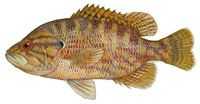Warmouth

Species Details
Lepomis Gulosus
Centrarchidae
Perciformes
River, Lake, Swamp, Muddy, Vegetation
1 - 2 lbs.
4" - 12"
Warmouth (Lepomis gulosus) Fish Description
The Warmouth has around 16 nicknames; it is known as Strawberry Perch, Warmouth Bass, Mud bass, Redeye, Molly, Google-eye, Rock Bass, Weed Bass, Open Mouth, Morgan, Wood Bass, Stump Knocker, Red-eyed Bream, Mo-mouth, and Mudgapper. It belongs to the sunfish family just like the Largemouth Bass.
This species highly resembles the Rock Bass or Green Sunfish; the Warmouth is larger and heavier than the latter and has a much larger mouth. Additionally, the former has three spines whereas the Rock Bass has six spines on the anal fin.
The body of the Warmouth is typically golden or mottled brown; the males boast a bright orange spot on its dorsal fin. It may also have some purple tints all over its body. Its gill flaps are red and it has small teeth on the tongue. The Warmouth’s soft rays have some rows of dark spots.
It also has 3 or 5 purple or red marks across its operculum and eyes. The Warmouth is usually confused with rock bass;
Diet and Size
Adult Warmouths feed on mollusks, insects, shrimps, isopods, and small fishes. The juvenile ones basically eat small insects and zooplankton. Warmouths fall prey to herons, turtles, water snakes, and larger fishes. They are sight feeders who stealthily hide behind weeds, stumps, and other objects while waiting for their prey.
The Warmouth is generally 4 to 10 inches long, but some can grow up to 12 inches long. It can weigh around 2.25 pounds. They are reported to reach up to 8 years of age, but most of them survive only until 3.
Interesting Facts About the Warmouth
- The male Warmouths build nests near some vegetation; they construct them by fanning their tails to remove any silt or debris on the nesting area. They defend the nests aggressively from all including the female Warmouths.
- During their breeding season, the eyes of male Warmouths turn red.
- Warmouths may crossbreed with the Rock Bass or Green Sunfish and Bluegill.
- They can survive even in low-oxygen environments even while its sunfish cousins cannot.
- Warmouths have a higher tolerance for muddy water compared to other fish species.
- They possess mouths that are twice larger than their fish relatives.
- Warmouths suck their prey into their big mouths.
Fishing Techniques: How to Catch a Warmouth
Anglers love Warmouths because they can easily be caught. Cane poles with natural baits can be used as well as a spinning tackle with small lures and spinners. Small crayfish, worms, minnows, crickets, and some small artificial lures can be used.
Anglers must use very light reels and rods when fishing for Warmouths. They are usually caught along with the Bluegill using the same methods. Anglers can catch them best in shallow waters near vegetation, stumps, river banks, and trees.
Habitat and Distribution
Warmouths abound areas with lots of aquatic vegetation. They like muddy bottoms, swamps, lakes, and ponds.
They are generally found in the Gulf of Mexico, the Great Lakes and Mississippi River basins, and the Atlantic and Gulf drainages in New Mexico and Texas. They also reach the waters of the Chesapeake Bay, Rio Grande, and the southern parts of Canada.
Warmouths are also located in the following river drainages: Lake Okeechobee, Yellow River, Blackwater River, Suwannee River, Tampa Bay, Indian River, St. Mary’s River, and St. John’s River, among others.







